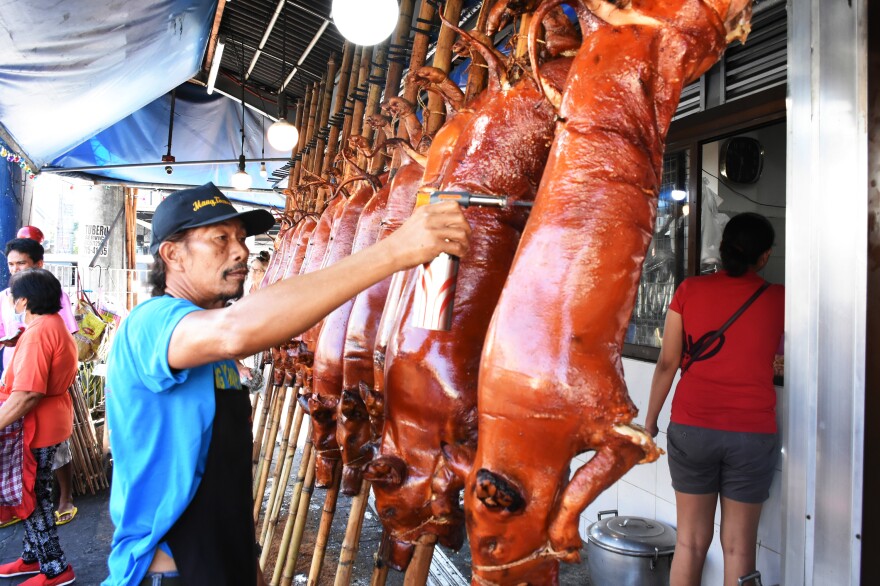Sleigh bells, snowy skies and a glowing fire evoke an idyllic Christmas. But the tropics can be just as festive as any wintry holiday this time of year.
The Philippines boasts the longest yuletide season in the world. September inaugurates the start of what is known as the "Ber" months (September, October, November and December) when parades, parties and concerts crowd the calendar of a season that is as visually resplendent as it is long.
Christmas parades boom through neighborhoods and villages of Manila. A wonderland of fairy lights lines the streets. Grand hotels glisten with extravagant decorations worthy of a czar's winter palace. On Manila's Policarpio Street, lavishly lit homes draw carolers and onlookers alike.

"Filipinos love to celebrate ... and they want the environment to be colorful," says 21-year-old marketing student Pau Escobedo.
Churches are wreathed in Christmas splendor, displaying life-size nativity scenes. More than 90 percent of the Philippines identify as Christian, the majority of them Roman Catholic, and consider faith central to their lives.
Making the season merry, musicians and performing artists are booked in every conceivable venue, says Martin Lopez, who promotes and showcases classically trained Filipino talent throughout the season.

But the real stars of the Christmas season appear to be the Filipino overseas workers. With 2.3 million Filipinos employed abroad, sending back a combined $31.3 billion in remittances last year, many make their one annual sojourn home for Christmas. These ex-pats even have an unofficial Christmas anthem:A ballad titled Sa Araw Ng Pasko ("On the Day of Christmas") about longing for home around the holidays fast became associated with Philippine migrant workers, remaining a classic 21 years after its release.
Sociologist Clifford Sorita, a former seminarian with the order of the Society of the Divine Word, says the frenzy surrounding the "Ber" months is bound up in the anticipation of the arrival of the overseas workers. "This is really a big homecoming," he says.
Sorita also says the "Ber" months represent "a psychological time clock for most Filipinos to prepare" a jammed Christmas calendar with family and friends.
Tending to her shoe stall at a sprawling Christmas bazaar in Manila, Katherine Mercado, 37, says the "Bers" help focus the mind at a time of distractions. "Come September, we remember the people we value for the upcoming Christmas," she says.
There's no precise timeline on when the "Ber" tradition began. Sorita says it grew organically.
Wilfrido Arcilla, a marketing consultant who teaches at Manila's Ateneo Graduate School of Business, says the Philippines' long run-up to Christmas is not "some grand design like Black Friday," meant to entice crowds into the malls to spend.
Instead, Arcilla says, the "Ber" season is a natural confluence of things that define Filipino culture: "The celebration of family and faith, fiesta and food, friends and fun." He says merchandisers are merely exploiting a Filipino passion for Christmas that predates shopping malls.
The Rev. Fr. Flavie Villanueva of Manila's National Shrine of the Sacred Heart says growing commercialism is a distinct aspect of the Filipino Christmas. But rather than "antagonize the faithful" by saying "No, no, no," he says the church is there to "complement" consumerism by reminding people of the spiritual significance of the season, and "liberate them from the enslaving thought that Christmas is mainly about buying gifts [and] partying."

If Misa de Gallo (Rooster's Mass) is any indication, the church is holding its own. Millions rise before dawn this season to attend the Mass, a holdover from the Spaniards who ruled the Philippines for more than 300 years until 1898. The Masses are celebrated over nine-consecutive days — the novena — from Dec. 16-24.
Villanueva says the ritual originated as dispensation for farmers who rose early to avoid the day's extreme heat; in the rest of the Hispanic world, the novena was at night. Today, Filipino parishioners also fill the pews for Simbang Gabi, which means Night Mass in the Philippines' Tagalog language.
The faithful endure the early hour because they believe that "when they complete these nine days ... their wishes would come true," Christianne Bituin, a 36-year-old new mother, says of Misa de Gallo.

Villanueva says people "broaden their faith according to their own understanding and lifestyle."
Carolyn Cheng, 60, has directed the choir at Manila's Mary the Queen Parish for 30 years. She calls Misa de Gallo "an expression of devotion" that helps "build anticipation of the feast." The die-hards "go straight from parties to mass," she laughs.
After all the food for the soul, there's some serious feasting.
No Filipino Christmas table is complete without roasted pig, or lechon, the whole pig, which can weigh between 26 and 44 pounds.
Rows of roasted pigs — run through with thick bamboo sticks — line the sidewalks of La Loma, a district in Quezon City considered the lechon capital of the Philippines. At theMang Tomas Native Lechon stall,workers take small blowtorches to the tough rinds, to burn off hair stubble.

Ariel De Los Reyes, the third-generation lechonero of this family business, says during the Christmas season they sell nearly 200 pigs a day, for about $150 a piece. Heads go for $50, and there's a run on them for centerpieces.
While pigs may have an honored place at many Filipino Christmas dinners, proprietor De Los Reyes says his family would "rather go to sleep than eat" on Dec. 25. "We're so tired. All those customers," he jokes.
By the time Christmas comes around, this family of pig roasters wants nothing to do with the lechon many of their fellow countrymen are savoring with friends and relatives. "We eat hot dogs, ham and hot cocoa," De Los Reyes laughs.
To be with loved ones is the No. 1 wish most Filipinos express for Christmas. When asked what he wanted, Michael Liwanag, a financial strategist, blurted out "world peace," and quickly amended that — just "peace and quiet."
Copyright 2021 NPR. To see more, visit https://www.npr.org. 9(MDAxNzg0MDExMDEyMTYyMjc1MDE3NGVmMw004))









